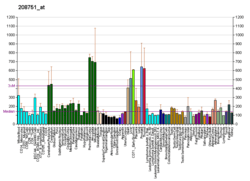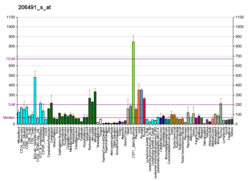NAPA (gene)
N-ethylmaleimide-sensitive factor Attachment Protein Alpha, also known as SNAP-α, is a protein that is involved in the intra-cellular trafficking and fusing of vesicles to target membranes in cells.[5]
Function
The 'SNARE hypothesis' is a model explaining the process of docking and fusion of vesicles to their target membranes. According to this model, membrane proteins from the vesicle (v-SNAREs) and proteins from the target membrane (t-SNAREs) govern the specificity of vesicle targeting and docking through mutual recognition. Once the 2 classes of SNAREs bind to each other, they form a complex that recruits the general elements of the fusion apparatus, namely NSF (N-ethylmaleimide-sensitive factor) and SNAPs (soluble NSF-attachment proteins), to the site of membrane fusion, thereby forming the 20S fusion complex. Alpha- and gamma-SNAP are found in a wide range of tissues and act synergistically in intra-Golgi transport. The sequence of the predicted 295-amino acid human protein encoded by NAPA shares 37%, 60%, and 67% identity with the sequences of yeast, Drosophila, and squid alpha-SNAP, respectively. Platelets contain some of the same proteins, including NSF, p115/TAP, alpha-SNAP (this protein), gamma-SNAP, and the t-SNAREs syntaxin-2 and syntaxin-4, that are used in many vesicular transport processes in other cell types. Platelet exocytosis uses a molecular mechanism similar to that used by other secretory cells, such as neurons, although the proteins used by the platelet and their modes of regulation may be quite different.
Clinical significance
NAPA is abnormally expressed in fetuses of both IVF and ICSI, which may contribute to the increased risk of birth defects in these methods of assisted reproductive technology, ART.[6]
Interactions
NAPA has been shown to interact with:
References
- 1 2 3 GRCh38: Ensembl release 89: ENSG00000105402 - Ensembl, May 2017
- 1 2 3 GRCm38: Ensembl release 89: ENSMUSG00000006024 - Ensembl, May 2017
- ↑ "Human PubMed Reference:".
- ↑ "Mouse PubMed Reference:".
- ↑ Clary DO, Griff IC, Rothman JE (1990). "SNAPs, a family of NSF attachment proteins involved in intracellular membrane fusion in animals and yeast". Cell. 61: 709–21. doi:10.1016/0092-8674(90)90482-t. PMID 2111733.
- ↑ Zhang Y, Zhang YL, Feng C, Wu YT, Liu AX, Sheng JZ, Cai J, Huang HF (September 2008). "Comparative proteomic analysis of human placenta derived from assisted reproductive technology". Proteomics. 8 (20): 4344–56. doi:10.1002/pmic.200800294. PMID 18792929.
- 1 2 Hanson PI, Otto H, Barton N, Jahn R (Jul 1995). "The N-ethylmaleimide-sensitive fusion protein and alpha-SNAP induce a conformational change in syntaxin". J. Biol. Chem. 270 (28): 16955–61. doi:10.1074/jbc.270.28.16955. PMID 7622514.
- ↑ Barnard RJ, Morgan A, Burgoyne RD (Nov 1997). "Stimulation of NSF ATPase activity by alpha-SNAP is required for SNARE complex disassembly and exocytosis". J. Cell Biol. 139 (4): 875–83. doi:10.1083/jcb.139.4.875. PMC 2139964. PMID 9362506.
- 1 2 3 Rual JF, Venkatesan K, Hao T, Hirozane-Kishikawa T, Dricot A, Li N, Berriz GF, Gibbons FD, Dreze M, Ayivi-Guedehoussou N, Klitgord N, Simon C, Boxem M, Milstein S, Rosenberg J, Goldberg DS, Zhang LV, Wong SL, Franklin G, Li S, Albala JS, Lim J, Fraughton C, Llamosas E, Cevik S, Bex C, Lamesch P, Sikorski RS, Vandenhaute J, Zoghbi HY, Smolyar A, Bosak S, Sequerra R, Doucette-Stamm L, Cusick ME, Hill DE, Roth FP, Vidal M (Oct 2005). "Towards a proteome-scale map of the human protein-protein interaction network". Nature. 437 (7062): 1173–8. doi:10.1038/nature04209. PMID 16189514.
- ↑ McMahon HT, Missler M, Li C, Südhof TC (Oct 1995). "Complexins: cytosolic proteins that regulate SNAP receptor function". Cell. 83 (1): 111–9. doi:10.1016/0092-8674(95)90239-2. PMID 7553862.
- ↑ Rabouille C, Kondo H, Newman R, Hui N, Freemont P, Warren G (Mar 1998). "Syntaxin 5 is a common component of the NSF- and p97-mediated reassembly pathways of Golgi cisternae from mitotic Golgi fragments in vitro". Cell. 92 (5): 603–10. doi:10.1016/s0092-8674(00)81128-9. PMID 9506515.
- ↑ Miao Y, Miner C, Zhang L, Hanson PI, Dani A, Vig M (July 2013). "An essential and NSF independent role for α-SNAP in store-operated calcium entry". eLIFE. 2: e00802. doi:10.7554/eLife.00802. PMC 3713520. PMID 23878724.
Further reading
- Wilson DW, Whiteheart SW, Wiedmann M, Brunner M, Rothman JE (1992). "A multisubunit particle implicated in membrane fusion". J. Cell Biol. 117 (3): 531–8. doi:10.1083/jcb.117.3.531. PMC 2289450. PMID 1315316.
- Whiteheart SW, Brunner M, Wilson DW, Wiedmann M, Rothman JE (1992). "Soluble N-ethylmaleimide-sensitive fusion attachment proteins (SNAPs) bind to a multi-SNAP receptor complex in Golgi membranes". J. Biol. Chem. 267 (17): 12239–43. PMID 1601890.
- Hanson PI, Otto H, Barton N, Jahn R (1995). "The N-ethylmaleimide-sensitive fusion protein and alpha-SNAP induce a conformational change in syntaxin". J. Biol. Chem. 270 (28): 16955–61. doi:10.1074/jbc.270.28.16955. PMID 7622514.
- Whiteheart SW, Griff IC, Brunner M, Clary DO, Mayer T, Buhrow SA, Rothman JE (1993). "SNAP family of NSF attachment proteins includes a brain-specific isoform". Nature. 362 (6418): 353–5. doi:10.1038/362353a0. PMID 8455721.
- Timmers KI, Clark AE, Omatsu-Kanbe M, Whiteheart SW, Bennett MK, Holman GD, Cushman SW (1997). "Identification of SNAP receptors in rat adipose cell membrane fractions and in SNARE complexes co-immunoprecipitated with epitope-tagged N-ethylmaleimide-sensitive fusion protein". Biochem. J. 320 (Pt 2): 429–36. doi:10.1042/bj3200429. PMC 1217948. PMID 8973549.
- Lemons PP, Chen D, Bernstein AM, Bennett MK, Whiteheart SW (1997). "Regulated secretion in platelets: identification of elements of the platelet exocytosis machinery". Blood. 90 (4): 1490–500. PMID 9269766.
- Subramaniam VN, Loh E, Hong W (1997). "N-Ethylmaleimide-sensitive factor (NSF) and alpha-soluble NSF attachment proteins (SNAP) mediate dissociation of GS28-syntaxin 5 Golgi SNAP receptors (SNARE) complex". J. Biol. Chem. 272 (41): 25441–4. doi:10.1074/jbc.272.41.25441. PMID 9325254.
- Lowe SL, Peter F, Subramaniam VN, Wong SH, Hong W (1997). "A SNARE involved in protein transport through the Golgi apparatus". Nature. 389 (6653): 881–4. doi:10.1038/39923. PMID 9349823.
- Barnard RJ, Morgan A, Burgoyne RD (1997). "Stimulation of NSF ATPase Activity by α-SNAP Is Required for SNARE Complex Disassembly and Exocytosis". J. Cell Biol. 139 (4): 875–83. doi:10.1083/jcb.139.4.875. PMC 2139964. PMID 9362506.
- Wong SH, Xu Y, Zhang T, Hong W (1998). "Syntaxin 7, a novel syntaxin member associated with the early endosomal compartment". J. Biol. Chem. 273 (1): 375–80. doi:10.1074/jbc.273.1.375. PMID 9417091.
- Tang BL, Tan AE, Lim LK, Lee SS, Low DY, Hong W (1998). "Syntaxin 12, a member of the syntaxin family localized to the endosome". J. Biol. Chem. 273 (12): 6944–50. doi:10.1074/jbc.273.12.6944. PMID 9507000.
- Wong SH, Zhang T, Xu Y, Subramaniam VN, Griffiths G, Hong W (1998). "Endobrevin, a Novel Synaptobrevin/VAMP-Like Protein Preferentially Associated with the Early Endosome". Mol. Biol. Cell. 9 (6): 1549–63. doi:10.1091/mbc.9.6.1549. PMC 25382. PMID 9614193.
- Osten P, Srivastava S, Inman GJ, Vilim FS, Khatri L, Lee LM, States BA, Einheber S, Milner TA, Hanson PI, Ziff EB (1998). "The AMPA receptor GluR2 C terminus can mediate a reversible, ATP-dependent interaction with NSF and alpha- and beta-SNAPs". Neuron. 21 (1): 99–110. doi:10.1016/S0896-6273(00)80518-8. PMID 9697855.
- Prekeris R, Klumperman J, Chen YA, Scheller RH (1998). "Syntaxin 13 Mediates Cycling of Plasma Membrane Proteins via Tubulovesicular Recycling Endosomes". J. Cell Biol. 143 (4): 957–71. doi:10.1083/jcb.143.4.957. PMC 2132958. PMID 9817754.
- Nagamatsu S, Watanabe T, Nakamichi Y, Yamamura C, Tsuzuki K, Matsushima S (1999). "alpha-soluble N-ethylmaleimide-sensitive factor attachment protein is expressed in pancreatic beta cells and functions in insulin but not gamma-aminobutyric acid secretion". J. Biol. Chem. 274 (12): 8053–60. doi:10.1074/jbc.274.12.8053. PMID 10075705.
- Subramaniam VN, Loh E, Horstmann H, Habermann A, Xu Y, Coe J, Griffiths G, Hong W (2000). "Preferential association of syntaxin 8 with the early endosome". J. Cell Sci. 113 (6): 997–1008. PMID 10683148.
- Hirose H, Arasaki K, Dohmae N, Takio K, Hatsuzawa K, Nagahama M, Tani K, Yamamoto A, Tohyama M, Tagaya M (2005). "Implication of ZW10 in membrane trafficking between the endoplasmic reticulum and Golgi". EMBO J. 23 (6): 1267–78. doi:10.1038/sj.emboj.7600135. PMC 381410. PMID 15029241.
- Singh BB, Lockwich TP, Bandyopadhyay BC, Liu X, Bollimuntha S, Brazer SC, Combs C, Das S, Leenders AG, Sheng ZH, Knepper MA, Ambudkar SV, Ambudkar IS (2004). "VAMP2-dependent exocytosis regulates plasma membrane insertion of TRPC3 channels and contributes to agonist-stimulated Ca2+ influx". Mol. Cell. 15 (4): 635–46. doi:10.1016/j.molcel.2004.07.010. PMID 15327778.





